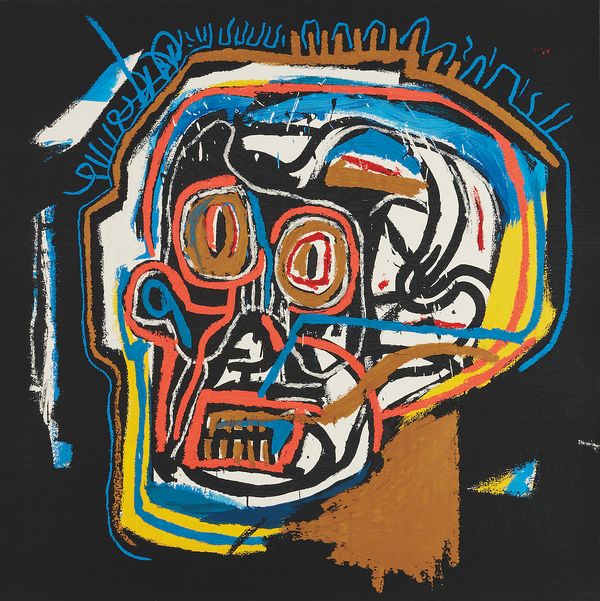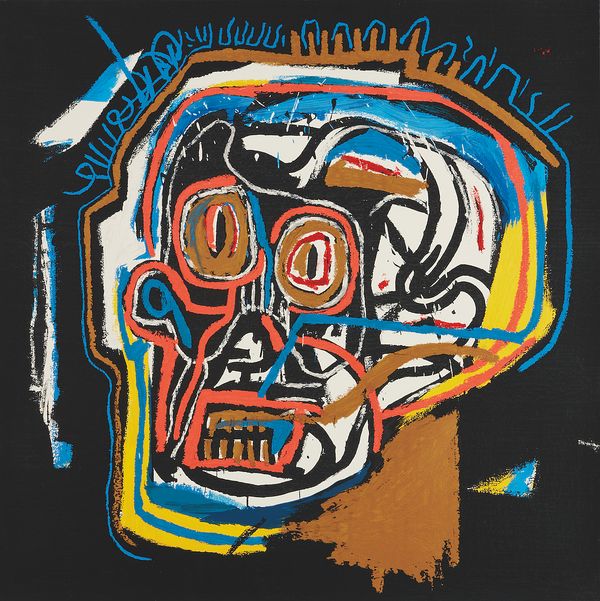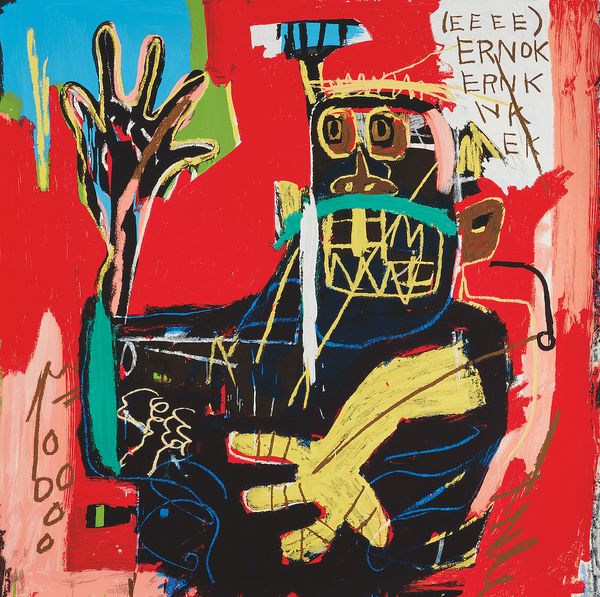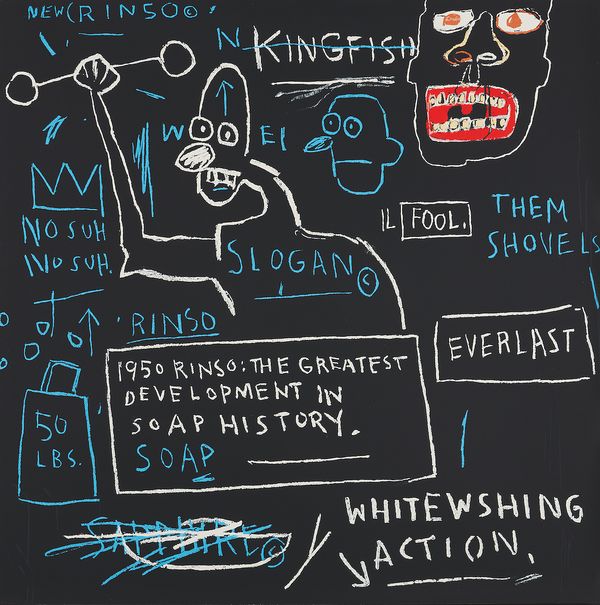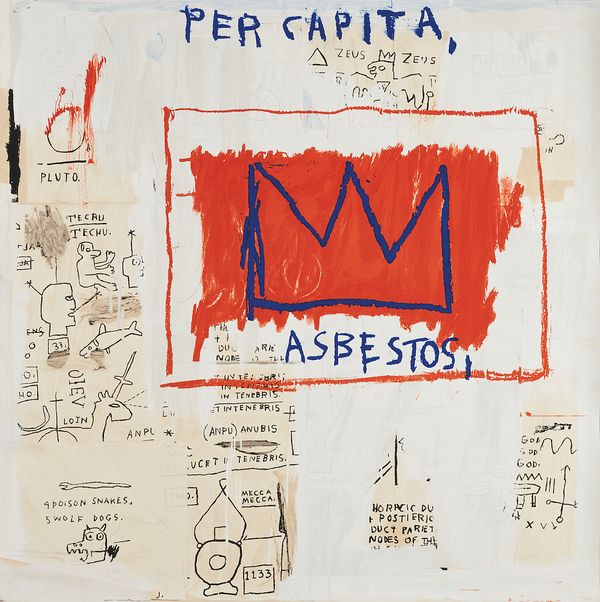After Jean-Michel Basquiat, Portfolio I (one of four screenprints), 1983-2001. Estimate $300,000 - 500,000. Editions & Works on Paper New York.
I don’t think about art when I’m working, I try to think about life
Portfolio I captures the essence of Jean-Michel Basquiat as an aesthetic pioneer and a critically aware artist. Basquiat synthesized his urban and Afro-Caribbean influences, and his Neo-Expressionist style to create works not typically shown in fine art spaces. The four images chosen for Portfolio I not only encapsulate his iconic handling of paint but are emblematic of his ability to epitomize the tenor of modern society. This set of four prints was published by the Jean-Michel Basquiat estate under the guidance of his father Gerard, who signed each print on the reverse.
Untitled (Head)
After Jean-Michel Basquiat, Portfolio I (one of four screenprints), 1983-2001. Estimate $300,000 - 500,000. Editions & Works on Paper New York.
One of Basquiat’s most recognizable images, Untitled (Head) is rendered in the artist’s signature bold colors contrasted against a flat black background, the rounded white stretches are evocative of skull bones, while red and brown demarcate key facial features. Despite the ghoulish qualities of the skull, the head is expressive and vibrant, and the eyes are alert. The viewer cannot help but question Basquiat’s intention when confronted with this juxtaposition. The composite imagery of the skull within the articulated face plays to Basquiat’s complex understanding of the relationship between the inner self and the perception of the outer world. By presenting his difficult personal experiences, like racism, isolation, and drug addiction, Basquiat exposed the public to his innermost feelings and addressed universal struggles.
Untitled (Ernok)
After Jean-Michel Basquiat, Portfolio I (one of four screenprints), 1983-2001. Estimate $300,000 - 500,000. Editions & Works on Paper New York.
In his bold and colorful style, Basquiat reintroduced elements absent from the minimalist and abstract work of his predecessors, like the human figure. An early interest in the human form, and a gifted copy of Grey’s Anatomy, sparked and fueled the repeated presence of skulls, and disembodied parts in many of Basquiat’s compositions. Untitled (Ernok) features, a man with an x-ray view of veins in a transparent right hand. He too seems surprised by the state of his hand, blurring the usually firm line between the internal and the external self. Basquiat initiates the viewer in a questioning of the body by making an internal process visible. This close examination of the body reflects how the artist and others like him were made to consider themselves, physically and otherwise, in society. Basquiat’s revelation confronts the day-to-day experience of those othered by society.
Untitled (Rinso)
After Jean-Michel Basquiat, Portfolio I (one of four screenprints), 1983-2001. Estimate $300,000 - 500,000. Editions & Works on Paper New York.
Beyond the struggle of the personal and the public, Basquiat brought attention to broadly encompassing issues of race and class. He was a poignant critic of materialistic culture, using layers of text and images to evoke the impact of advertisements. In Untitled (Rinso) Basquiat’s sporadic language and inflated imagery read as a dark infomercial, combining the enthusiastic language of advertisement with the insidious implication that the product is a tool of anti-blackness. Although the language is disjointed and sporadic, the composite pictures communicate a complex history of racism in advertisement. Basquiat’s suggestive language and imagery bring issues of race and commodification to the fore and confront audiences with systems in which they passively participate.
Untitled (Per Capita)
After Jean-Michel Basquiat, Portfolio I (one of four screenprints), 1983-2001. Estimate $300,000 - 500,000. Editions & Works on Paper New York.
Untitled (Per Capita) embodies both the composite technique and layers of meaning that make the artist's work captivating and culturally relevant. Referencing the 1981 painting also known as Untitled (Per Capita) the print contains elusive layers of imagery, which compel the viewer to look to his other works for synthesis and clarity. A commonly reappearing symbol in Basquiat’s work, the three-pointed crown occupies a central place amidst layers of painted-over drawings of religious symbols. Basquiat often used crowns or more abstract halos to mark the majesty of his artistic influences and personal heroes, many of whom were African American athletes and artists. Elevating black culture creators in ways they were not typically depicted in Western culture, Basquiat paid homage to their achievements and placed himself in their company by crowning himself as their successor. In the context of Untitled (Per Capita), the crown is placed prominently over the boldly inscribed word “Asbestos,” which Basquiat used in several works as a symbol of corporate greed and the prioritization of capital over human health. The position of the crown in combination with the title Per Capita suggests the triumph of individuals over the evils of society. One could read this positive message as an affirmation of Basquiat’s belief in the ability of people to achieve influence despite their circumstances, as he did in the art world.
Gallery Tour | Editions New York | Spring 2021
Meet the superb team behind curating this spring's robust Editions sale featuring works by Andy Warhol, Roy Lichtenstein, Jackson Pollock and Jasper Johns. This auction is set to be one of the largest in Phillips' history; featuring 175 artists, spanning 414 lots, to be auctioned in an evening sale and three day sessions.
Discover More from Editions & Works on Paper New York >
Recommended Reading
Basquiat's Kings >
Basquiat: Royalty, Heroism, and the Streets >
